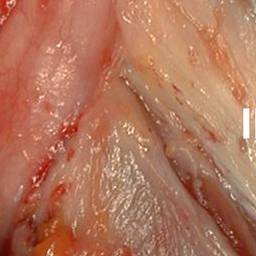
A 23-year-old baseball pitcher suffers from pain and altered sensations in his right thigh during practice
A 23-year-old amateur baseball pitcher presented with complaints of pain in the right inguinal area and dysesthesia in the anterolateral thigh during pitching practice. The patient was left-hand dominant and the pain was in the right thigh and inguinal region. He stated that his symptoms had been present for more than a year. Moreover, his symptoms gradually worsened during the past 2 months prior to this presentation.
Examination revealed local tenderness medial to the right anterior superior iliac spine (ASIS), the anatomical location where the lateral femoral cutaneous nerve (LFCN) passes under the inguinal ligament. Additionally, the Tinel’s test of the LFCN exacerbated the pain and it radiated to the anterolateral thigh.
Besides the tenderness, there was partial sensory loss in the upper anterolateral thigh, however there were no other neurologic findings.
X-rays of lumbar spine and pelvis did not reveal any abnormal findings.
Based on the patient’s history, he being a left-handed baseball pitcher, and the clinical manifestations, the doctors suspected meralgia paresthetica.
Meralgia Paresthetica is a nerve entrapment which results in pain, numbness, tingling, burning, prickling sensations, and loss of sensation within the distribution of the lateral femoral cutaneous nerve. It most often occurs in individuals between 30 and 40 years of age. The incidence rate is 4.3 cases per 10,000 patient-years in the general population, however, diabetes increases this rate substantially. Gymnastics, baseball, soccer, bodybuilding, and strenuous exercises increase the risk. Moreover, other causes include pregnancy, obesity-associated panniculus, external compression due to tight clothing, belts or gun holsters, diabetes, hypothyroidism, iliac bone graft harvesting, trauma, and surgical scarring.
To confirm the diagnosis in this patient, they then performed a local anaesthetic nerve block of the lateral femoral cutaneous nerve. As soon as they injected a local anaesthetic agent with corticosteroid in the tender region, the symptoms resolved immediately after. However, the relief was temporary, and the symptoms reappeared in a few hours.
The procedure was repeated. However, neither repeated local corticosteroid injections, oral nonsteroidal anti-inflammatory drugs nor physical therapies produced adequate pain relief, the doctors decided to proceed with the surgical exploration of the LFCN a month after the presentation.
Neurolysis of the LFCN and partial excision of the sartorius fascia and inguinal ligament were performed. Subsequently, the symptoms resolved immediately after the surgery. Moreover, a month later, the patient was able to resume pitching. He returned to a baseball game as a pitcher 3 months later. There was no recurrence of symptoms.
Reference:
Otoshi K, Itoh Y, Tsujino A, Kikuchi S. Case report: meralgia paresthetica in a baseball pitcher. Clin Orthop Relat Res. 2008;466(9):2268-2270. doi:10.1007/s11999-008-0307-3



